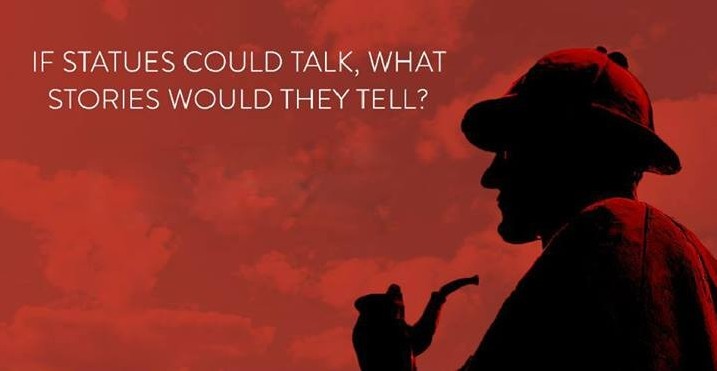This summer, 35 statues across London and Manchester have woken to articulate life in an engaging, original and immersive project.
The brainchild of Sing London’s Colette Hiller, Talking Statues draws on the technical expertise of renowned cultural technologists Antenna Lab.
The concept is simple: notice a statue; swipe your phone on an NFC tag nearby, scan a QR code or type in a short URL, and your phone will ring. The statue – Queen Victoria, Peter Pan, Brunel -is calling you. There’s no sense of didacticism –  this is no audio-guide or potted history – this is just the statue talking directly to the listener.
this is no audio-guide or potted history – this is just the statue talking directly to the listener.
Blooloop spoke to Colette Hiller, director of Sing London and to Jessica Taylor, VP of Experience Design and who heads up Antenna Lab, about this inspirational project that has got everybody talking.
Arts producers Sing London commissioned celebrated writers and actors including to create monologues for the statues; technology was provided by Antenna Lab and funding came from The Digital R&D Fund for the Arts – a fund that comes from NESTA, the Arts Council and the Arts and Humanities Research Council.
It’s an idea that is stunning in its essential simplicity, says Taylor: “That’s when you know something is a good idea. Colette approached me probably a year and a half ago now to say, ‘Look, I’ve got this idea.’ She told me the idea and before she could even finish the sentence I said, ‘Yes – Antenna Lab would be very happy to do anything you want with this.’”
Low Cost Technology, Ground Breaking Experiences
There’s more to the project than an engaging novelty. It’s also a research and development project which explores how low-cost technology can deliver ground breaking experiences, as well as harvesting and analysing data on user engagement and objectives. The Research Centre for Museums and Galleries at the University of Leicester will be collecting the data generated by the technology. Findings will provide information on the value of the technology to museums and cultural organisations, and what that means for the future of mobile user experiences and cultural interpretation.
The project received funding from the NESTA Digital R&D fund. The idea was to test the viability of various technologies for  the museum and cultural sector. Taylor explains, “The reason we selected NFC and QR (we added mobile URL as well) was not because we think they’re cutting-edge technology – they’re not, we use them in our Oyster cards all the time – it was to provide an intuitive and really easy experience. We want the tech to be completely invisible.”
the museum and cultural sector. Taylor explains, “The reason we selected NFC and QR (we added mobile URL as well) was not because we think they’re cutting-edge technology – they’re not, we use them in our Oyster cards all the time – it was to provide an intuitive and really easy experience. We want the tech to be completely invisible.”
There is no need to download an app or wait for wifi. This is about passers-by simply taking out their phone and swiping it over the NFC tag (or typing in the mobile URL or reading the QR code) and instantly getting a phone-call from the statue.
Taylor adds, “It is very much Colette’s idea, but from Antenna Lab’s point of view what we’re interested in is the delivery mechanism – easy, low-cost, low barrier to entry technology. We’re working with the other partner on the project, the University of Leicester. They’re going to be gathering data from this project and it will all form part of a White Paper as part of our funding from Nesta. We’ll be feeding back to the cultural sector.
“Our mother company is Antenna International and we have amazing relationships with some of the greatest museums and cultural institutions in the world and one of the things we’re really excited about is whether NFC or other technology might help museums break out from behind their museum walls and tell their stories in different ways.”
Simplicity, Serendipity and Spontaneity
It’s a low-tech ground-breaking concept that uses everyday, unremarkable technology to create something magical and out of the ordinary; to make the overlooked artworks that surround us visible by giving them a voice, and to connect people in a new way – an emotional way -with their physical environment. Taylor says, “You only have to look at Colette’s and Sing London’s previous projects to see what she’s interested in: spontaneous moments of joy.”
She adds that the reactions she has witnessed so far from those who have happened on the Talking Statues is an initial incredulity – they can’t believe they are receiving a call from a statue – which gives way to enchantment at the content. And it is very high quality content: a stellar company of writers and actors have come together to create and voice these monologues, variously funny, lyrical and moving, all compelling, which were serialised on Radio 4’s Front row during the week of the launch.
People are more used to thinking about this technology in terms of commercial transactions. As Taylor says, “I think once people understand that they can access this great content, maybe that’ll be a bit of a mind-shift.”
This project is about, she adds, serendipity and spontaneity, and that’s the essentially the simple beauty of the idea.
“We look at different uses of technology as part of our work at Antenna Lab, and we’re always thinking of the user experience first rather than technology leading. I think that’s particularly important to make sure we’re really clear about what we want the user experience to be, and with Talking Statues I think this is the perfect example of that. Everything had to be in the service of Colette’s vision. That’s how we designed it, and we’re really proud of it for that reason.”
Sing London
Hiller, Sing London’s artistic director, is adept at coming up with ideas for engaging the public in a social and perception-altering way with what she refers to as ‘small interventions’. Talking Rubbish was a previous production, where London’s bins began speaking and thanking passers-by who put litter in them; Ping 2010 saw 100 ping-pong tables on the streets of London for moments of spontaneous fun, and it was under Sing London’s aegis that 30 pianos and lots of sheet music appeared across London in a bid to unite London in song.
Talking Statues, her latest brainwave, opened with a glittering launch at Samuel Johnson’s house in Gough Square on the 19th of August, under the inscrutable gaze of Hodge the Cat, one of the Talking Statues. (Hodge is voiced by Nicholas Parsons).
“It’s just that these statues have been around for all of these years, and you pass them by and they go unnoticed, and it suddenly occurs to you: what are they witnessing? What are they thinking? What might they be saying back to you? And I made it happen.”
Talking Statues
With Talking Statues, Colette has a number of aims. Firstly, she is aware that people pass statues every day for years without, quite often, having the faintest idea about the people they are meant to immortalise, “… and often they’re there for a  really important reason like they developed clean water or invented the postage stamp or something which is absolutely essential to us – so it’s paying tribute where tribute is due.
really important reason like they developed clean water or invented the postage stamp or something which is absolutely essential to us – so it’s paying tribute where tribute is due.
“On another side, Sing London projects are all about connecting the public with public spaces that we all share and making people a little bit more public-spirited. So in this way it’s calling your attention to public art, and making you enjoy it, and value it a little bit by way of entertainment.
She adds, “The magic is the phone ringing. The idea it’s not a museum guide. It’s very important you have this personal feeling that Victoria is ringing you and that’s what makes you smile to begin with, and then you listen very receptively. That’s one thing.
“Another is that although it’s on your phone, everything is telling you to look outwards, so while you’re listening, you’re really looking.
“The third thing to say is that it’s about why that statue is in that place: why is that goat on that load of crates in the middle of Spitalfields? Or why is Brunel actually there in that place? So wherever you’re using a bit of the physicality, the statue is telling you why they’re on that bridge or holding that sceptre.”
From Queen Victoria to Peter Pan
There are four different types of statues:
- Historic ones, like Queen Victoria, or Brunel. (Playing some notable characters from history are Jeremy Paxman as John Wilkes in Fetter Lane; Dominic West, as Achilles in Hyde Park; Prunella Scales, as Queen Victoria in Manchester’s Piccadilly Gardens; and Patrick Stewart as the voice of the unknown soldier at Paddington Station).
 The “slightly secret history ones that are people like Roland Hill who shouldn’t be secret because he invented the postage stamp.”
The “slightly secret history ones that are people like Roland Hill who shouldn’t be secret because he invented the postage stamp.”- Fictional characters like Peter Pan or Sherlock Holmes.
- Modern statues that have no history. And in that case the writer is creating a story. As Hiller says, “And it doesn’t matter that the story they’re creating is fiction, because while you’re listening, you’re looking, and that is precisely what the artist wants you to do.” Novelist and playwright Lucy Caldwell, for example, has given words to the young girl in the Broad family at Broadgate; and those words are articulated by the actress Maisie Williams from Game of Thrones. The story to her piece is that these statues play the game of statues: they follow human beings and freeze if anyone turns around to see them, before they can be spotted moving.
The Talking Statues phenomenon is happening in Manchester as well as London, where Lowry is voiced by David Neilson and Lincoln by Tom Conti, among others – the Reading Girl, for instance, written by Jacqueline Wilson and voiced by Jenna Louise Coleman.
Lowry’s monologue uses his own quotes. Similarly Queen Victoria’s monologue – which is voiced by Prunella Scales –was written by playwright and historian, Katrina Hendrey, who used mostly genuine quotations.
Hiller adds, “And then on the other side you have Mark Ravenhill in Manchester writing in verse for Russel Tovey about Alan Turing, and it’s abstract, and it’s very moving, and it’s in verse.”
Research and Development

Mentioning the research being undertaken by Leicester University in conjunction with The Digital R&D Fund for the Arts, Hiller said, “We get analytics about who has been using which statue, so that every day we will know which is the biggest talking statue. For the last few days it’s been Sherlock. And after you hear them speak, you’re told some facts about the statue and linked to a museum which in some way connects with that subject. We know that this is working: Hodge [the cat that belonged to Doctor Johnson] has his statue outside Samuel Johnson’s house, which is a museum, and we know that visitor numbers at the museum have tripled in the last week because of Hodge the cat.”
The project, powered by Antenna Lab, will continue to connect people in a new way with public artworks for a year. Hiller qualifies this: “ I would very much like to do different cities next. Our big thing now is looking for the right corporate to take this to Florence, and Paris, and Amsterdam. We are also hoping to take it round England. It all just depends on funding.”
There are thirty-five Talking Statues – and four more waiting mutely to be given voices. The public is invited to submit short monologues of no more than four hundred words for these statues, and the winning monologues will be recorded by actors and included in the project.

















